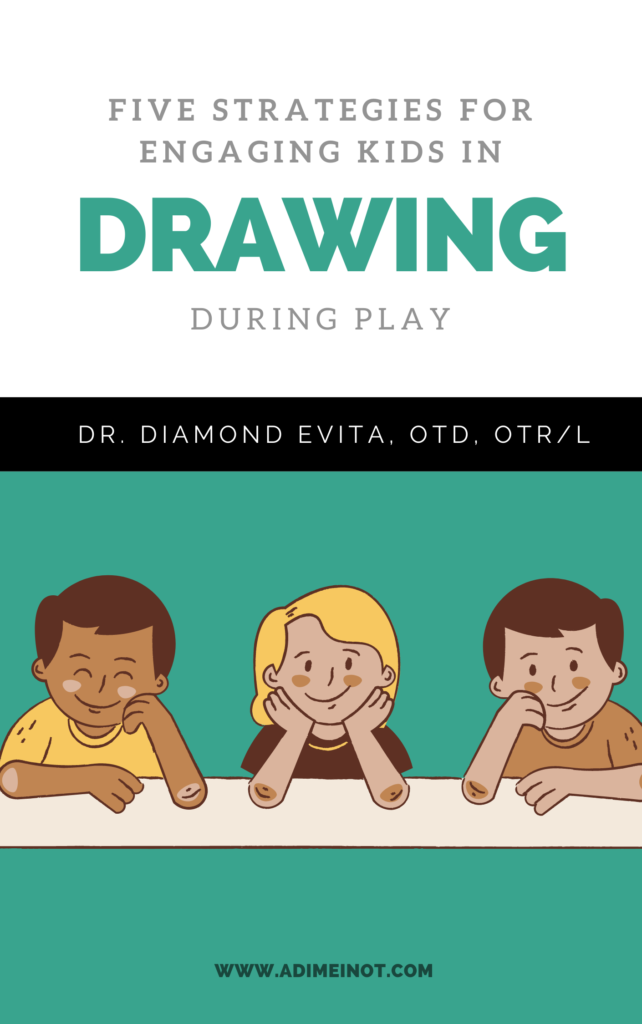You go to the pediatrician check-up. They ask if your child is scribbling, or perhaps drawing basic shapes. “Yes”, may be the response for some families. Or perhaps you recall your child breaking or trying to eat the crayons. Or showing no interest in what you scribble on the paper. Maybe it seems like your kid isn’t interested in drawing.

Perhaps while talking with pediatricians, daycare staff, speech therapists, or occupational therapists, you’ve heard about developmental milestones. But you aren’t sure how to help your child reach them.
This is for you.
Shifting Our Mindset on Fine Motor Development
First, know that these strategies come from a strengths-based approach. Every child has their own path, and some children learn new skills differently. Some children are autistic, ADHD-ers, or have sensory processing differences; and those differences should be accommodated and honored. These tips are only general strategies to support interest in drawing and should not replace working with licensed rehab professional.
Five Drawing Strategies to Try
- Follow their interests and strengths, not the milestone. What we know about milestones is that they are based on neurotypical development. Not all children develop in the same order. If your kid isn’t interested in drawing, I say this to say, take a deep breath. What skills and interests do you notice about your child? Can you incorporate shape recognition or pre-writing skills into their play in other ways? Take a lot of time to observe what draws them in. Join in their play without an agenda and see what you discover.
- Use different mediums. If the activity is limited by the materials you’re using, try to change the materials. For example, if your child tends to try to eat the crayons, start with making a food safe paint (or using condiments). Use these to explore lines, curves, squiggles and more! Other suggestions include: using a magnadoodle, painting with water, bath markers, chalk, or making shapes with 3-D materials like playdoh.
- Build on underlying skills, including hand strength. How does your child do with holding a spoon, a whisk, a measuring cup, etc? Build up areas that involve fine motor skills (or motor skills with small muscles in our hands) and that gives your child one less thing to have to concentrate on.
- Use concrete examples. Sometimes in learning opportunities, us adults don’t give great instructions. We put a sheet of paper and a marker and say “let’s draw!”
….draw what? Anything? How?
Try to use modeling and visual examples just as much as verbal directions. For example, I may say, “let’s draw a train track!”. Then I model drawing the lines with sound effects and provide an opportunity for the child to try. This way they’ve seen the beginning of the activity modeled and have a visual support on what to do. - Use familiar themes with songs, videos, books, and incorporate movement! Music can go a long way! Use a favorite song to model different directions our writing utensil can go. If we’re not ready to hold on to an utensil, try learning the motions for songs together, like “Wheels on the Bus” or “Itsy Bitsy Spider”. If your child likes rainbows, draw a rainbow together! If your child enjoys letters or numbers, find fun ways to trace letters in our names.
And that brings me back to point #1. You don’t have to go in order. Every child develops differently. So maybe it works for your family if you work on drawing the number 0, or tracing letter X before you’re drawing a square. It’s ok.
It’s ok. <3
To save and share this as a resource, save the images below!
Thanks for listening. I hope this was helpful for you in finding information, and some grace for yourself as a parent.
Dr. Dime


One thought on “My Kid Isn’t Interested in Drawing”